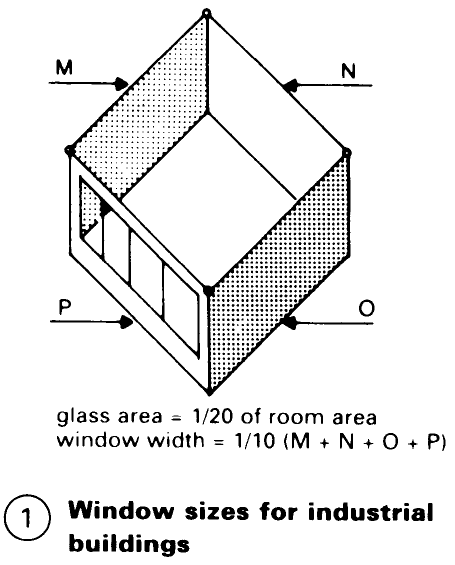Windows: Size. Windows: Shading
If daylight is considered to be essential for the use to which a room will be put, then windows are an unavoidable necessity. Simple apertures for daylight have developed into significant stylistic features, from Romanesque semicircular arched windows to Baroque windows surrounded by rich, elaborate decoration.
In the European cultural region lying north of the Alps, window forms reveal particularly strong features. In contrast to the climatically favoured cultural region of the Mediterranean, daily life here mainly had to be spent indoors. The people were thus dependent upon daylight because artificial light was expensive and good illumination of a room during the hours of darkness was beyond the means of most of the local population.
Every work area needs a window leading to the outside world. The window area which transmits light must be at least 1/20 of the surface area of the floor in the work space. The total width of all the windows must amount to at least 1/10 of the total width of all the walls, i.e. 1/10 (M + N + О + P) – (1).

For workrooms which are 3.5m or more high, the light transmission surface of the window must be at least 30% of the outside wall surface, i.e. > 0.3 A x В – (2).

For workrooms with dimensions similar to those of a living room, the following rules should be applied.
Minimum height of the glass surface, 1.3m – (3).

Height of the window breast from the ground, > 0.9 m.
The total height of all windows must be 50% of the width of the workroom, i.e. Q = 0.5R – (4).

When calculating the window size for a living room, both the floor area of the room and the angle of incidence of the light must be taken into account (5). Here, 'a' is the minimum window size for a living room as a percentage of the floor area of the room, 'b' is the minimum size for a kitchen window and 'c' is the minimum size for all other rooms. The angle of incidence of the light is 'd’ The larger the angle of incidence, the larger the windows need to be. This is because the closer the neighbouring houses are, and the higher they are, the greater the angle of incidence and the smaller the amount of light penetrating into the house. Larger windows will compensate for this smaller quantity of light.

Dutch regulations stipulate the sizes of windows in relation to the angle of incidence of the light.
Windows: Shading. Protection measures must prevent glare and regulate the inflow of heat from sunlight. In incidence of light are preferred, whereas in hot climates, small window apertures still allow sufficient light to enter.
Venetian blinds – (13) (with flat slats of wood, aluminium or plastic), roller shutters, roller blinds and partially angled sun blinds are all useful and can be adjusted as required. Fixed external devices are clearly less flexible than retractable or adjustable ones. Vertical panel blinds – (15) (either fixed or pivoting around the axis of the slat) are also suitable for tall or angled window surfaces.


Heat rising up the face of a building should be able to escape, and not be blocked by external sun screens or allowed to enter the building via open skylights.
Internal shades are less effective than external ones for reducing solar heat gain because the heat they absorb is released into the room.
Date added: 2023-01-01; views: 596;
